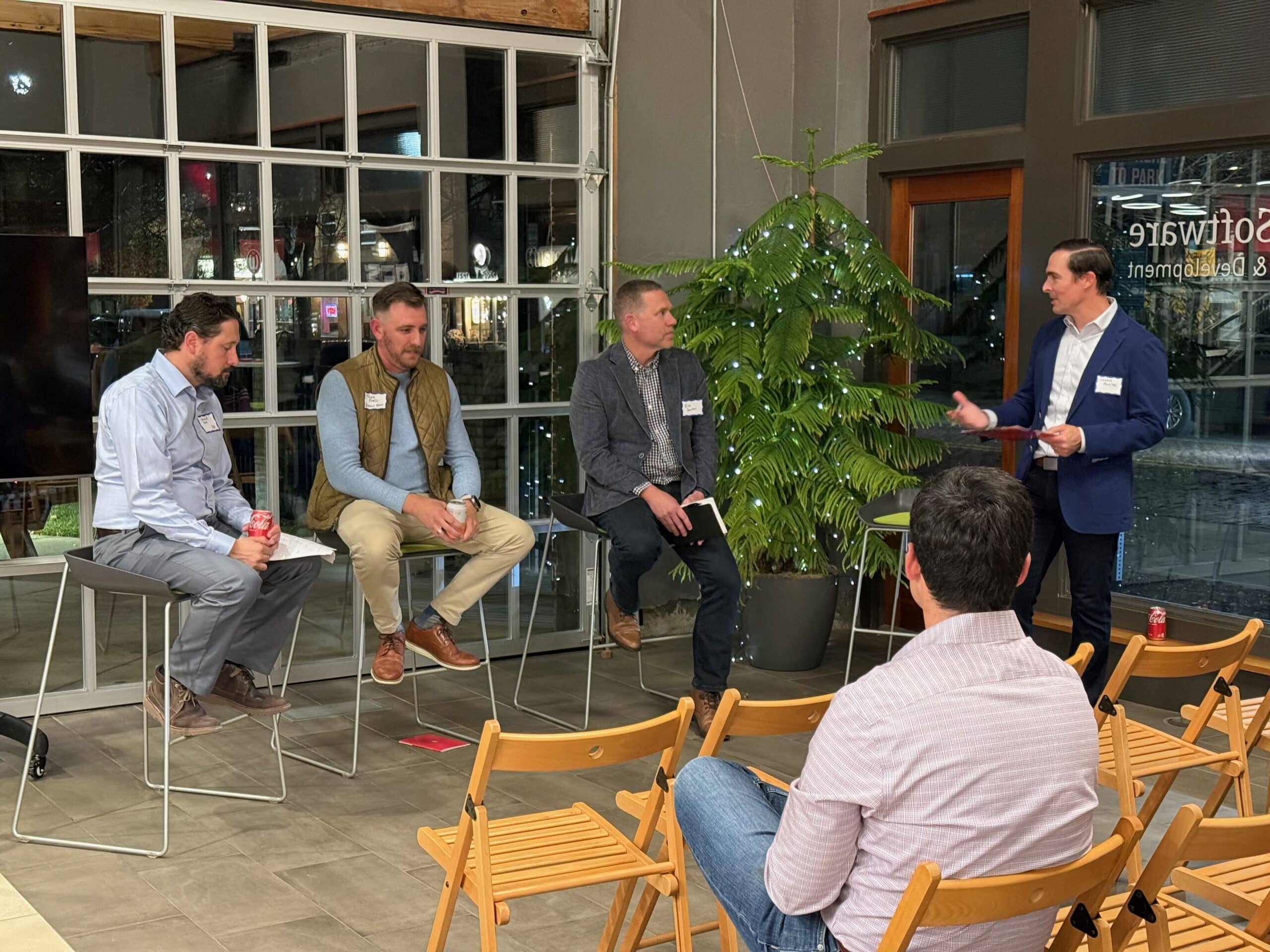On Nov. 7, 2024, I had the pleasure of moderating a panel conversation about navigating change and uncertainty at Atomic Object. We hosted three fantastic business leaders from Grand Rapids to participate in the conversation:
- Howard Paul, COO of Array of Engineers
- Tyler Ford, General Manager of Hydraulics and Actuation at Eaton Aerospace
- Rick Harlow, Partner at Physics
Each panelist had something interesting to bring to the conversation from their career experience, and I enjoyed the open and honest conversation about navigating change and uncertainty. I’m excited to share a few of the highlights from the conversation. I hope hearing the short versions of these stories is as inspiring to you as the conversation was to me.
Howard Paul on Living Out Your Values
After an interesting career as an aerospace engineer working for a variety of organizations like NASA and L-3 Communications, Howard joined his wife, Stacey, to form their own business. In early 2018, Array of Engineers was born. Howard shared that their goal was to create an environment empowering engineers to be creative and to solve worthwhile and challenging problems as consultants.
In March 2020, only two years after founding Array of Engineers, the COVID-19 pandemic struck and challenged their growing business. A major project was delayed indefinitely, and new prospects were scarce. Howard and Stacey faced a difficult decision about what to do with their team. Keeping them on without billable work would stretch finances severely, but reducing their staff would hinder their ability to recover when business picked up and damage the culture they sought to build.
They decided to keep everyone on board and invest in building tools that would be valuable for future work. Making that call and sticking to that plan as time stretched on wasn’t easy. It also wasn’t a given that the investment would work out. But, leaning on their values as the foundation for their direction in the uncertainty of the COVID-19 pandemic created purpose and clarity for their team. And, happily, the bet has paid off for the Array of Engineers team. Those tools now drive a significant line of business, and the team has a deep understanding of Howard’s and Stacey’s level of commitment to the values they’ve instilled in the team.
Tyler Ford on the Value of Relationships
Tyler started his career at Eaton Aerospace in 2008 and has continued to work within Eaton’s Aerospace division through today (16 years!). While I was preparing for the panel, I noticed role changes noted on Tyler’s LinkedIn profile about every two or three years. Sometimes it was promotions in the same group, and other times it involved moving to different groups. Tyler shared that was the result of Eaton’s cadence of change plus his ambition to chase interesting challenges. And it provided a lot of content for a conversation about change.
During the panel conversation, Tyler shared a story about one of his promotions where he became the manager of a more experienced coworker who had also been interested in the same role. Some frustration threatened to strain the relationship they’d built as peers. It could be tempting to avoid conflict in this situation. However, because Tyler valued their relationship and respected his coworker, they got together over a beer to set a tone of openness and feedback in their continuing relationship.
Leaning into relationships and open, honest conversations was a major theme of conversation with Tyler. He also shared that one of the reasons he appreciates working with Howard and the Array of Engineers team is that they pick up the phone and call when they need to have an important conversation. To Tyler, relationships are at least as valuable as technical competence. Taking the time to have a phone call or face-to-face conversation, and being present, open, and honest in the conversation are some of the best ways to build a real relationship.
Rick Harlow on the Story Arc of Innovation
Rick has worked with a variety of organizations over his career. So, I was curious to hear what insights he would bring from that experience. We talked quite a bit before and during the panel about the grand story arc of innovation, how organizations engage in that activity over time, and how that can inform an organization’s approach to thriving in change.
Rick observed that organizations tend to follow a waxing and waning cycle of investment in innovation. At times, they make more bets on innovative ideas. They might staff an innovation team focused on that effort, or foster that activity within various teams across the organization. The work to improve and try new things gets attention and investment, sometimes to excess. Taken to an extreme, it can lead to a fractured product ecosystem or a devaluing of innovation work if it lacks the discipline to drive results.
At other times, organizations underinvest in innovation. They change very little and run few experiments. Work might be focused instead on consolidation or simplification to control costs. This work can be innovative but isn’t commonly approached that way. Innovation teams and initiatives often lose the investment and attention in this phase, leading to an atrophied ability to innovate over time.
For long-term success, organizations must build a sustained innovation practice, including (and perhaps most importantly) when facing significant changes or challenges. Applying discipline to drive visible results and finding sustainable ways to fund that innovation is what helps organizations continue innovating through a variety of circumstances. Organizations can better respond to change and uncertainty by building this sustained innovation capacity.
How do you navigate change and uncertainty?
I hope you find these stories and insights inspiring as you face your own journey. If you’d like to share, comment with your stories of navigating change and uncertainty.

